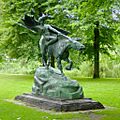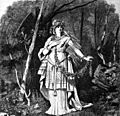Valkyrie facts for kids

Valkyries (pronounced VAL-kuh-rees) are special female figures in Norse mythology. Their name comes from the Old Norse words Valkyrja, which means "Choosers of the Slain." They work for the powerful god Odin, who is the chief god in Norse myths.
The main job of the Valkyries is to fly over battlefields. They look for warriors who have died bravely in combat. Once they choose a hero, they carry that warrior's spirit to Valhalla. Valhalla is a grand hall in Asgard, where Odin lives. The chosen warriors are called einherjars. In Valhalla, these warriors prepare to fight alongside Odin in a huge battle called Ragnarök. Ragnarök is believed to be the end of the world. Valkyries also serve drinks and take care of the warriors who feast in Valhalla.
Long ago, people in Norse lands imagined Valkyries riding huge wolves. They also thought Valkyries had black wings, like ravens. Both wolves and ravens were seen near battlefields, eating from fallen warriors. This made them symbols of death and destruction. But as Christianity spread, the idea of Valkyries changed. People started to see them as beautiful women, a more Romantic image.
Valkyries in Opera
A famous composer named Richard Wagner created several operas that feature Valkyries. In German, Valkyries are called Walküren (singular: Walküre). Some of his operas that include them are Die Walküre, Siegfried, and Götterdämmerung.
These operas tell the story of a Valkyrie named Brünnhilde. She is punished for not obeying her father, Odin. Later, she falls in love with a hero named Siegfried. One of the most famous pieces of music from these operas is from the start of Act Three of Die Walküre. It is known as the Ride of the Valkyries.
Related pages
Images for kids
-
Walkyrien (around 1905) by Emil Doepler
-
Valkyrie (1908) by Stephan Sinding in Churchill Park, Copenhagen, Denmark
-
A Valkyrie talks with a raven (1862) by Anthony Frederick Augustus Sandys
-
The Rök Runestone
-
An Anglo-Saxon burial mound at Sutton Hoo in Suffolk, England
-
A Valkyrie looks at a bottle of "Rheingold" sekt in a 1901 advertisement
See also
 In Spanish: Valquiria para niños
In Spanish: Valquiria para niños





















